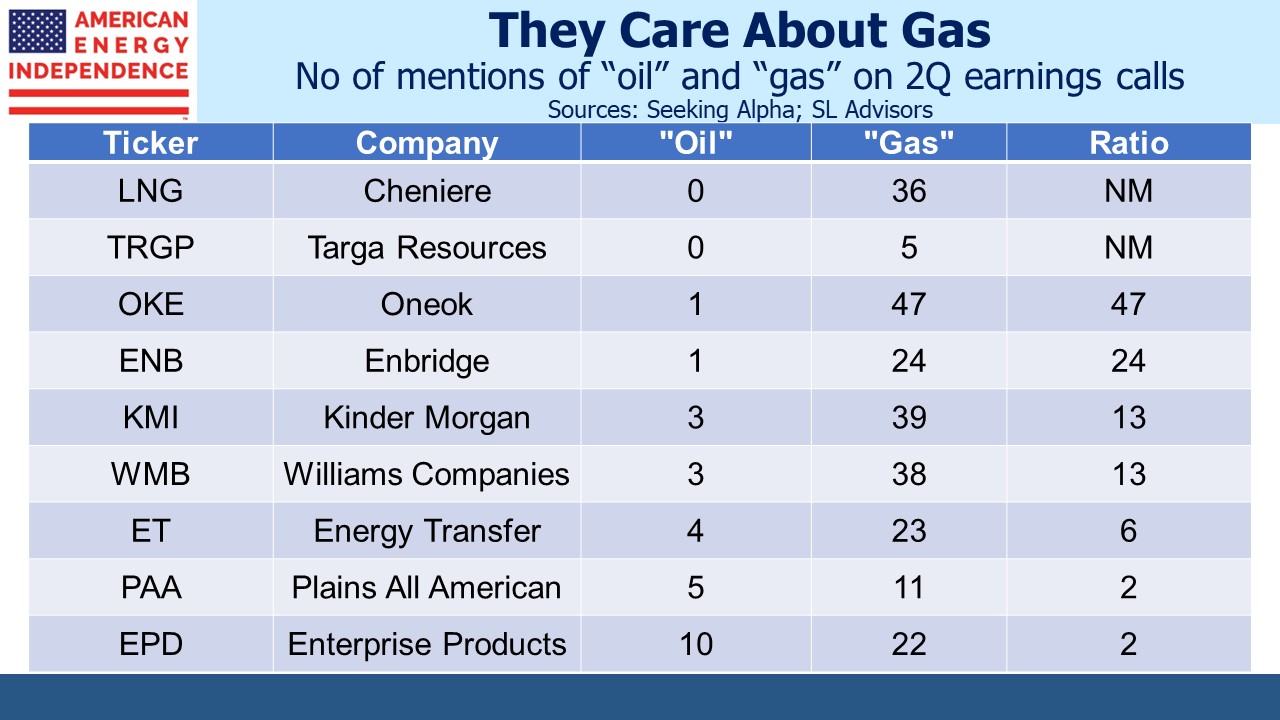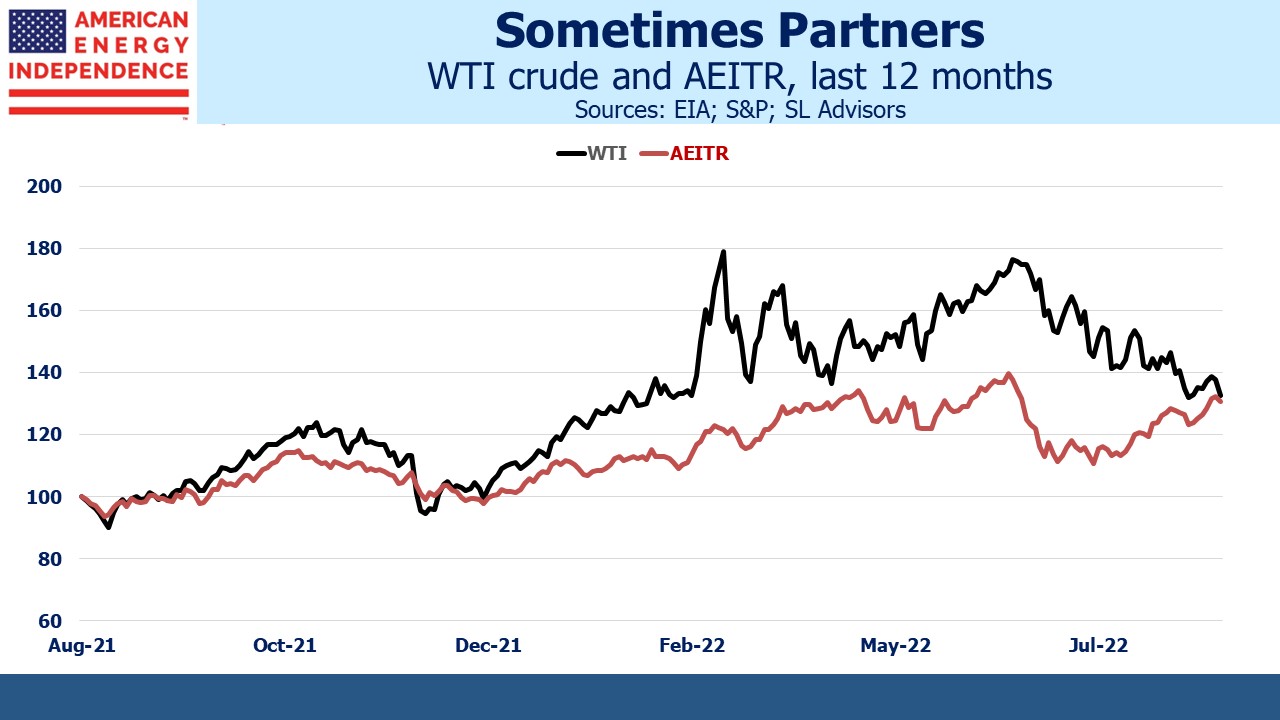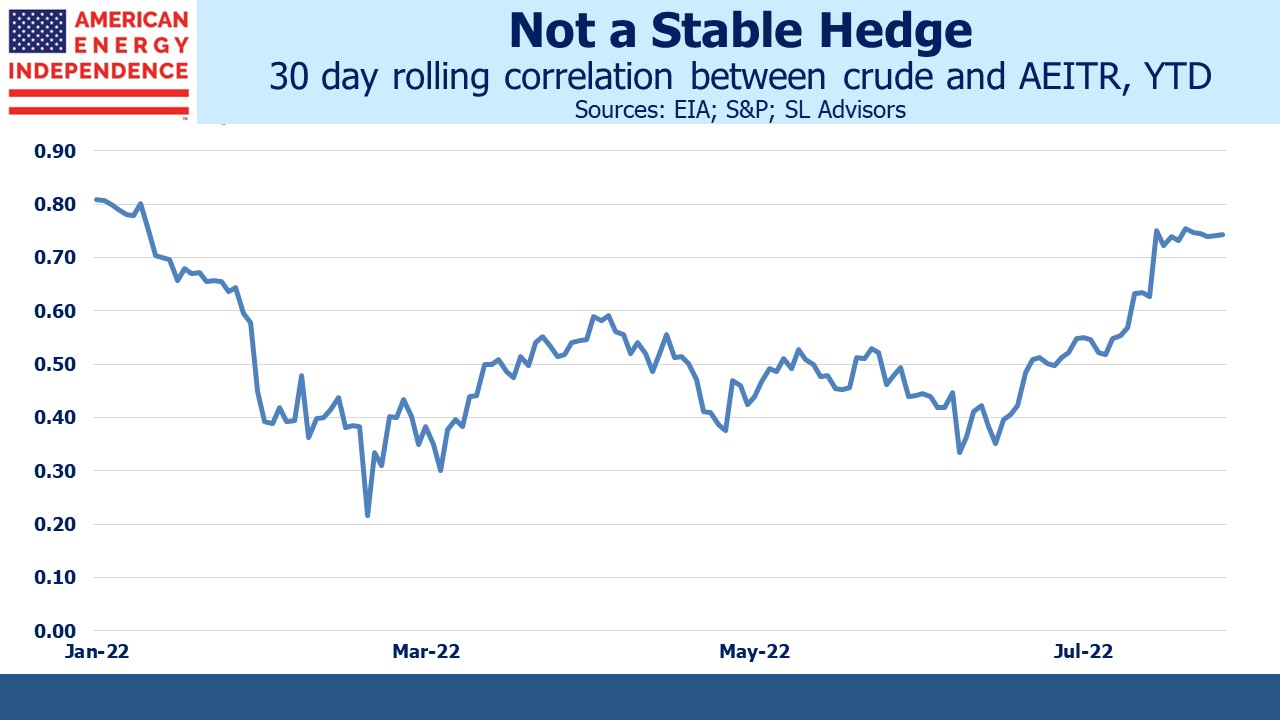Pipeline Stocks Resume Their Rally
Managing investments in pipeline companies, even with a bias towards natural gas as we have, nonetheless means explaining the relationship with crude oil. It measures energy investor sentiment like a Texas-sized barometer. A discussion about the near-term direction of oil is often an important timing consideration for many investors.
A simple count of the frequency of the words “gas” and “oil” in 2Q22 earnings call transcripts reveals what management teams spend their time pondering. It should be no surprise that Cheniere, exporter of half of America’s Liquefied Natural Gas (LNG) never mentioned crude oil at all. Or that Williams Companies, owner of the Transco natural gas pipeline that runs up the US east coast, mentioned natural gas 38 times and crude oil three. But even Plains All American, a dedicated crude pipeline company, favored natural gas twice as much in their comments. And a detailed review of the transcript confirms that they were not referring to gasoline.
Oil grabs the headlines while natural gas flows do the heavy lifting of driving financial performance for many of these companies although not all of them.
By coincidence, the one-year performance of the American Energy Independence Index (AEITR) and WTI crude are close at 31% and 33% respectively. Over the past year their daily returns have a correlation of 0.54. By contrast Henry Hub natural gas (the US benchmark) is +90% compared with a year ago.
However, the link between pipelines and crude is tenuous. In early June both fell, but since then the AEITR recovered around two thirds of its losses while the price of oil has continued to weaken. Their rolling 30 day correlation has fluctuated between 0.81 and 0.22 this year. The two move together more often than not, but the relationship is far too weak to allow for a portfolio of pipeline stocks to be hedged by shorting oil futures.
This is why successful investors in the sector consider pipeline fundamentals rather than the future price of crude oil in determining their exposure. The forward dividend yield on the AEITR is around 5.6%. With dividends growing at 5-6% and stock buybacks worth another 1-2% of market cap, a 12-13% total return (5.6+5.5+1.5) is a not unreasonable expectation. We are increasingly seeing income-oriented investors make allocation to the sector. A half per cent drop in yields would add another 9% in capital appreciation.
The US Energy Information Administration’s current Short Term Energy Outlook is forecasting US crude production of 12.7 Million Barrels per Day (MMB/D) next year, up from 11.9 this year; 100 Billion Cubic Feet per Day (BCF/D) of natural gas production versus 96.6 this year; 12.7 BCF/D of LNG exports next year versus 11.2 this year; and global consumption of petroleum and liquid fuels of 101.5 MMB/D in 2023, up from 99.4 this year.
Midstream energy infrastructure is a volume business, the outlook for which is positive.
The inappropriately named Inflation Reduction Act (IRA) was warmly received by several companies on recent earnings calls. They especially liked the $85 per ton tax credit for CO2 captured where it’s generated and permanently sequestered underground. Pipeline companies are well-suited to benefit from this, and since only tax-paying businesses can claim the credit it’s unlikely to attract many start-ups.
There’s also a credit of up to $180 per ton for pulling CO2 out of the ambient air. Given the relentless focus on global warming you might think we’re choking on an unhealthy excess, but the reality is that at 412 parts per million, there’s not much CO2 around. This means extracting it is expensive because you have to process enormous quantities of air. Encouragingly, the tax credit looks to be near the low end of the range of likely costs (see The Hard Math Of The Energy Transition). This could stimulate new business opportunities in the sector.
Other features in the IRA were less appealing – the corporate alternative minimum tax could represent as much as a 3% loss in NAV for pipeline corporations according to research from Wells Fargo, although they cautioned that this could be an overly conservative estimate. Expect tax lawyers to work on minimizing the impact.
The 1% tax on buybacks is unlikely to be material but is nonetheless bad tax policy because it now adds a third tax bite out of corporate profits before they reach the investor.
Overall passage of the IRA doesn’t seem to have hurt the midstream sector and the carbon capture opportunities might even make it a net positive. Prospects remain very good.
Two other stories caught my eye. The Financial Times published ‘Extreme heat belt’ to place 100mn Americans at risk in 3 decades, research shows. Large swathes of the central US along with already hot places like Arizona and Florida are predicted to have more days of 125F within three decades. An economist lamented that, “Households and businesses alike continue to flock to markets throughout states like Texas, Florida, Arizona, Georgia and the Carolinas, despite the nation’s ever-increasing climate risks and challenges.”
Americans have been moving south for decades – sometimes for the politics but often for the climate. We like warm weather. 125F will be too hot for many, but winter in the northeast sucks and that’s why migration is south.
Bloomberg reported that the UK is importing LNG from Australia. The cargo was even transferred to a second vessel in Malaysia. That such a desperate and expensive purchase is worthwhile serves as another example of the failed policies engulfing Europe (see America Dodges The Energy Crisis). We are fortunate that New England’s energy policies haven’t spread or we might be doing the same as Britain.
We have three funds that seek to profit from this environment:
Please see important Legal Disclosures.


